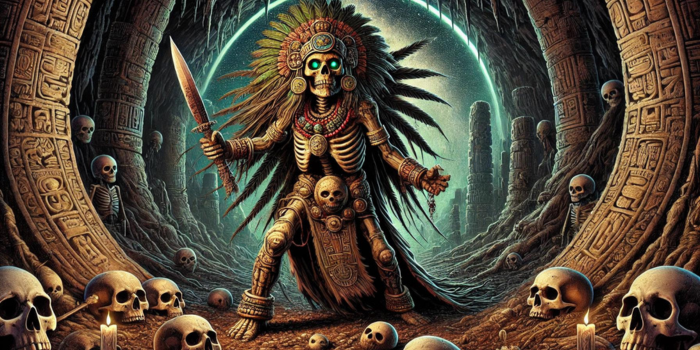
Mictlantecuhtli's Influence on Death and Transformation
|
|
Time to read 7 min
|
|
Time to read 7 min
Mictlantecuhtli, one of the principal gods in Aztec mythology, is revered as the god of the underworld, death, and the dead. As a ruler of Mictlan, the underworld, Mictlantecuhtli plays a crucial role in the Aztec belief system, overseeing the realm where souls reside after death. His influence extends across various aspects of life and death, embodying the cycle of existence and the inevitability of mortality.
Unlock the Mysteries of the Ars Goetia with a Free Oracle Tarot Reading , performed by the most experienced masters of Terra Incognita . This powerful reading is not a game—it is a serious and profound spiritual tool designed to provide clarity, guidance, and transformation. Only sincere requests are taken into consideration, ensuring that each reading is handled with the utmost dedication and expertise. Your personalized results will be delivered within 48 hours , offering you the wisdom and insight you seek.
👉 Submit your request here: Free Ars Goetia Oracle Tarot Reading
Are you ready to uncover the answers hidden within the shadows?
Attuning to Mictlantecuhtli involves embracing the mysteries of death and the afterlife. To connect with this powerful deity, one might:
Connecting with Mictlantecuhtli requires a profound respect for the natural cycle of life and death. Practitioners might also engage in activities that honor the dead, such as participating in Day of the Dead celebrations, which are deeply rooted in Aztec traditions.
Mictlantecuhtli is often associated with the planet Saturn. Saturn, known for its connection to time, death, and transformation, mirrors Mictlantecuhtli's dominion over the underworld and the passage of souls. This planetary association underscores the themes of mortality and the cycles of life and death. Saturn's influence brings a sense of order and structure to the chaotic nature of death, aligning with Mictlantecuhtli's role as a ruler of the underworld.
Obsidian is the metal most closely linked to Mictlantecuhtli. This volcanic glass, used by the Aztecs for tools and rituals, symbolizes death, transformation, and the mysteries of the underworld. Obsidian's dark, reflective surface is seen as a portal to other realms, aligning with Mictlantecuhtli's role as a guide through the afterlife. The use of obsidian in sacrificial rituals and burial practices highlights its importance in honoring Mictlantecuhtli and invoking his power.
The element of Mictlantecuhtli is Earth, representing the grave and the physical aspect of death. Earth symbolizes the final resting place for bodies and the source from which new life emerges. This element reflects Mictlantecuhtli's connection to burial rites and the cyclical nature of life and death. Earth rituals, such as burial ceremonies and offerings of soil, are ways to honor Mictlantecuhtli and seek his blessings for safe passage into the afterlife.
Mictlantecuhtli is associated with the astrological sign of Scorpio. Scorpio, ruled by Pluto, shares attributes of death, transformation, and the exploration of the unknown. The intense and mysterious nature of Scorpio aligns with Mictlantecuhtli's role as the lord of the underworld, guiding souls through the darkness. Scorpio's connection to rebirth and regeneration also reflects the transformative power of Mictlantecuhtli, who oversees the cycle of life and death.
Offerings to Mictlantecuhtli can include:
These offerings serve to honor Mictlantecuhtli and seek his guidance and protection in matters of death and the afterlife. They also help to create a bridge between the living and the dead, fostering a deeper understanding of the cyclical nature of existence.
Mictlantecuhtli interacts with several other deities in Aztec mythology:
Mictlantecuhtli has been a central figure in Aztec culture, influencing rituals, ceremonies, and art. He is often depicted in codices and sculptures, symbolizing the Aztec understanding of death and the afterlife. His imagery is prevalent during the Day of the Dead celebrations, reflecting his enduring cultural significance. These celebrations, with their vibrant altars and offerings, honor Mictlantecuhtli's role and ensure that the dead are remembered and respected.
Mictlantecuhtli has appeared in various movies and TV shows, often depicted as a fearsome and powerful figure. Notable portrayals include:
Mictlantecuhtli is a prominent figure in literature, especially in works exploring Aztec mythology. Noteworthy mentions include:
Despite his significant role, several misconceptions surround Mictlantecuhtli:
Demon and Spirit Attunements, Amulets, and Grimoires are potent spiritual tools crafted to align your energy with powerful entities, offering protection, guidance, and healing. These sacred items bridge the gap between the earthly and spiritual realms, enabling you to connect with higher forces for clarity, empowerment, and inner strength. By wearing a demon or spirit amulet or engaging with a grimoire, you invite these potent energies into your life, providing ongoing support and shielding against negativity.
Demon and Spirit Attunements work to fine-tune your spiritual vibrations, enhancing your connection with specific entities and boosting your intuitive abilities. These practices create a comprehensive spiritual approach that not only protects you from harm but also opens pathways to profound transformation, spiritual growth, and inner wisdom. Through these tools, you harness the ancient powers of demons and spirits, forging a path toward deeper understanding and personal empowerment.